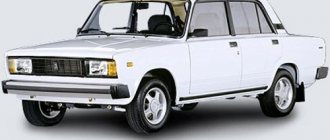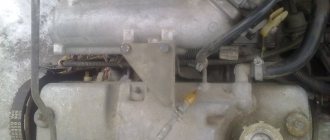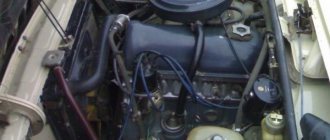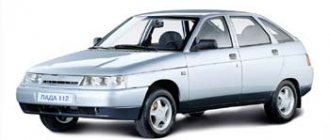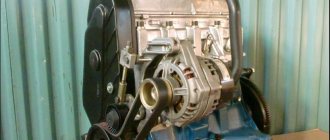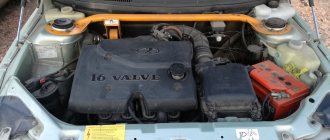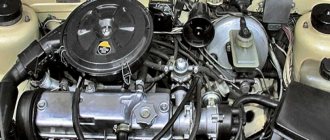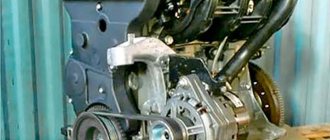The VAZ 1111 engine is a development of a domestic automaker, which was installed in the Oka car. The exact displacement of this power unit is 649 cubic centimeters. At the same time, the engine is capable of producing maximum power up to 30 horsepower.
Manufacturers were able to achieve such indicators thanks to two cylinders, each of which has 4 valves. The engine was powered by a carburetor. And if we’re not talking quite seriously, then the manufacturers simply sawed off half of everyone’s favorite engine installed under the hood of the VAZ-2108.
Specifications
| Engine capacity, cc | 649 |
| Maximum power, hp | 30 |
| Maximum torque, N*m (kg*m) at rpm. | 44 (4) / 3400 |
| Fuel used | Gasoline AI-92 |
| Fuel consumption, l/100 km | 4.7 |
| engine's type | In-line, 2-cylinder |
| Add. engine information | Carburetor, overhead valve timing system with overhead camshaft |
| Maximum power, hp (kW) at rpm | 30 (22) / 5600 |
| Cylinder diameter, mm | 76 |
| Piston stroke, mm | 71 |
| Number of valves per cylinder | 2 |
"Oka" SeAZ
In 2006, the small car division in Naberezhnye Chelny was sold, and therefore the production of the “little Kamaz” was overthrown, and the Oka was now produced only at the Serpukhov plant. But the demand for an obsolete car was no longer the same, and in order to somehow arouse interest among buyers, SeAZ decided to modernize the brand.
In 2006, Oka began to be equipped with a Chinese-made 1.0 liter engine, the modification was named SeAZ-11116. But the demand for the car was falling, and besides, it was unprofitable to produce a small car, and in 2008, mass production of the model was discontinued.
Peculiarities
The VAZ 1111 Oka engine works on such a principle that its entire process occurs in just two revolutions of the crankshaft. This allows the power unit not to experience heavy loads in the form of vibrations. But if such problems arise, then in order to compensate for them, manufacturers have installed two balancing shafts aimed at reducing vibrations.
The supply of the fuel mixture is controlled using a carburetor. The lubrication system is created by installing a gear pump, which makes it possible to take engine oil from the crankcase and deliver it to the friction pairs of the camshaft and crankshaft. In this case, the cylinders are irrigated by the formation of oil mist during operation, and the gas distribution mechanism and valve curtains are lubricated by gravity.
The weight of the VAZ 1111 engine is only 66.5 kilograms without clutch and gearbox. Therefore, its power is quite enough to achieve normal acceleration rates for the car under the hood of which it is installed.
The cylinder head is made of aluminum, which allows for a relatively small mass of the power unit, while the block itself is made of cast iron. The gas distribution mechanism is driven by a belt.
The cylinder diameter is 76 millimeters, and the piston stroke is 71 millimeters. Thanks to this combination, it is possible to obtain a compression ratio of 9.9 to one.
VAZ 1113 engine structure
1 — oil pan; 2 - balance shaft; 3 — cylinder block; 4 — oil receiver; 5 — cover of the first main bearing; 6 - oil pump; 7 — generator drive pulley; 8 - crankshaft; 9 — timing belt of the camshaft drive; 10 — toothed pulley of the coolant pump; 11 — oil filter; 12 — tension roller; 13 - camshaft; 14 — camshaft gear pulley: 15 — cylinder head cover; 16 — filler neck cover; 17-camshaft bearing housing; 18 — fuel pump; 19 — housing of auxiliary units; 20 — eccentric for driving the fuel pump; 21 — spark moment sensor; 22 — adjusting washer; 23 — valve pusher; 24 — valve guide; 25 - valve; 26 — valve seat; 27 — coolant temperature indicator sensor; 28 - piston; 29 — connecting rod; 30 — oil level indicator; 31 - flywheel; 32 — drive gear of the balancing shafts; 33 — balance shaft gear; 34 — crankshaft rear oil seal holder.
Advantages
Since the engine capacity of the VAZ 1111 is only 649 cubic centimeters, which is achieved with just two cylinders, there is practically no need to talk about positive qualities. If you pull your ears, you can give a few examples:
- Ease of maintenance and availability of spare parts. Since this engine is in fact half of a 1.3 liter VAZ 2108 engine, all spare parts are interchangeable.
- Small expense. But this is only a subjective concept, since a motor with such a volume cannot burn a large amount of fuel in principle.
Piston dimensions
Defects of engine parts
When replacing parts of the connecting rod and piston group, it is necessary to select pistons to cylinders by diameter and weight, as well as piston pins to pistons by diameter and connecting rods by weight.
The following data is stamped on the piston bottom:
1
- piston class by pin hole (1, 2, 3)
2
- piston class by diameter (A, B, C, D, E)
3
- arrow showing the direction of installation of the piston
4
- weight group (normal - “G” , increased by 5 g - “+”, decreased by 5 g - “-“)
5
- repair size (diameter increased by 0.4 mm - D, by 0.8 - E)
The cylinder class (A, B, C, D, E) is stamped on the bottom plane of the block (the mating plane under the oil sump).
For the convenience of selecting pistons to cylinders by diameter, both are divided into five classes: A, B, C, D, E (every 0.1 mm). Spare parts include pistons of nominal sizes of three classes A, C, E and two repair sizes. The first repair size is increased by 0.4 mm, the second - by 0.8 mm.
Based on weight, pistons are divided into three groups: normal, increased by 5 g and decreased by 5 g. Pistons of the same group must be installed on the engine.
For repair size pistons, spare parts include repair size rings increased by 0.4 and 0.8 mm. The number “40” is stamped on the rings of the first repair size, and “80” on the second.
Nominal sizes of cylinder and pistons diameters, mm
When selecting pistons for cylinders, determine the gap between them as the difference between the measured diameters of the piston and cylinder.
The nominal gap is set to 0.025-0.045 mm, the maximum permissible is 0.15 mm. If the gap does not exceed 0.15 mm, you can select pistons from subsequent classes so that the gap is as close as possible to the nominal one. If the gap exceeds 0.15 mm, bore the cylinders to the next repair size and install pistons of the corresponding repair size. Both cylinders are bored to the repair size, even if the gap between the piston and the cylinder exceeds the maximum permissible in only one cylinder.
Piston pins are divided by diameter into three classes (1, 2, 3) every 0.004 mm. The class of the finger is marked on its end with paint. The piston pin class is stamped on the piston bottom, and the connecting rod pin class is stamped on the connecting rod cap.
Size classes of piston pins and pistons
Selection of crankshaft liners
Nominal diameter of crankshaft journals, mm:
main 50.799-50.819 connecting rod 47.830-47.850
The crankshaft journals can be ground to one of four repair sizes with a reduction in the nominal diameter of the journals, mm:
Problems
Despite the small number of advantages, problems with this engine occur quite often. But this is not surprising, since the characteristics of the VAZ 1111 engine clearly contribute to this. Among the main negative qualities are the following:
- When the timing belt breaks, the valve bends. Unlike its brother VAZ 11113, the valve mechanism fails and often comes into contact with the pistons, so you need to monitor the belt very carefully.
- The balancing shaft gears are made of textolite, which is a rather soft material. This entails that after a short mileage they simply break.
- The cooling system of the power unit brings a lot of problems to owners of cars with such an engine. But everything is caused not by the fact that it is not sufficiently developed, but by the fact that the details in it are not of sufficient quality.
- Under the hood of the car, strange sounds are constantly heard, the cause of which is unadjusted valves. Despite all the apparent seriousness, this can be fixed very easily, even on your own in the garage.
- The cylinder head gasket is of very poor quality, so it can break through literally after a few kilometers.
- The ignition system is poorly protected from moisture, so driving a car with such an engine under the hood in rainy weather is highly not recommended.
- The carburetor can throw out its whims, so the engine often begins to work unstably, and sometimes even “troubles”.
Reliability, weaknesses, maintainability
Reliability
Despite its small size and weak points, car owners consider the VAZ-1111 a reliable, economical and unpretentious engine. Numerous reviews are clear confirmation of what has been said.
For example, Vladimir writes: “... mileage 83,400 km... satisfied, no problems. At -25 it starts easily. I change the oil every 5-6 thousand km...”
Dmitry: “... the engine is reliable and unpretentious. During the time I used it I never climbed into it. It spins quite vigorously. The dynamics are not bad, especially for me, a lover of calm and careful driving. If necessary, the car accelerates to 120 km/h. Fuel consumption is low. On 10 liters in the city you can travel an average of 160-170 km...”
Most car enthusiasts note that engine breakdowns do not occur often, mainly due to the driver’s oversight. Constant attention to the engine - and there will be no problems. You can read about this in almost every review.
Of course, there are also negative statements. An example of such a review from NEMO: “... an eternally dying switch and twin coil, an overflowing carburetor, whose needles are consumables, but starting at -42 in a parking lot is confident...”. But there are only a few such (negative) reviews.
When upgrading an engine, designers place the reliability factor at the forefront. So, after another modification, the crankshaft and camshafts became more reliable.
The mileage declared by the manufacturer also indicates the reliability of the engine.
Weak spots
Despite the reduction in engine dimensions, it was not possible to avoid weak points.
Vibration. Despite constructive attempts (installation of balance shafts, a special crankshaft), it was not possible to completely eliminate this phenomenon on the engine. The main reason for the increased vibration is the two-cylinder design of the unit.
Often, car enthusiasts are concerned about the inability to start the engine “hot”. Here, in most cases, the fault is placed on the fuel pump, or more precisely on its problematic diaphragm.
For a successful start, you need to wait some time (until the pump cools down or, in extreme cases, put a wet rag on it). It is advisable to replace the pump diaphragm.
Possibility of overheating. Occurs due to the water pump or thermostat. Low quality components, and sometimes careless assembly, are the basis for the failure of these components.
The car owner can only monitor the coolant temperature more carefully and replace faulty components as soon as possible.
Knocks in the engine compartment when the engine is running. The reason must be sought in unregulated valves.
In addition, when the engine warms up after starting it, the balance shafts usually knock. This is a design feature of the motor that you will have to get used to.
Burnout of the cylinder head gasket. This may occur due to a manufacturing defect associated with installation or due to incorrect (incomplete) tightening of the head fastening.
For the VAZ-11113 engine, an additional weak point is failures in the operation of electronics, especially sensors. The problem can only be solved by a car service center.
Maintenance
Manufacturers claim that under conditions of modern use and proper maintenance, the VAZ 1111 engine has a service life of 120 thousand kilometers. Therefore, despite the large number of malfunctions, these units can be considered quite reliable, especially considering their category.
The main thing is to undergo maintenance on time, the scheduled period of which is 15 thousand kilometers. Maintenance involves changing the oil, and you need to use synthetic oils, and if you fill in semi-synthetic, then it needs to be changed every 10 thousand kilometers. Also, do not forget that it is necessary to flush the oil system and replace the corresponding filter. When choosing which oil to pour into the VAZ 1111 Oka engine, you need to know that it includes 2.5 liters of lubricant marked 5W-30.
Every 30 thousand mileage it is necessary to adjust the engine valve clearances. But unfortunately, everyone turns to the service or carries out this operation on their own only when necessary. At the same mileage, it is recommended to clean the carburetor and adjust the idle speed.
After 60 thousand mileage, it is necessary to replace the coolant, because if this is not done on time, the substance will begin to lose its lubricating properties, which will lead to a decrease in the service life of the system. With the same mileage, it is imperative to replace the timing belt.
Small KAMAZ
Although the development of the small car was carried out in Serpukhov, it was supposed to be launched into mass production in Elabuga, and since the city is located on the Kama River, the model was given the name “Kama” VAZ 1111. But due to the unstable economy then in the Soviet Union, there were no plans not destined to come true - the production of the brand in the planned volume (900 thousand cars per year) did not work out, and the Elabuga plant was repurposed. VAZ-1111 began to be produced in smaller volumes, and at other enterprises:
- at the Volzhsky Automobile Plant in Tolyatti;
- in Serpukhov (SeAZ);
- in Naberezhnye Chelny (ZMA).
In Togliatti, the production of a small car did not last long - its production on the main AvtoVAZ conveyor was unprofitable, and in 1995 the Oka was removed from the assembly line. The small car plant (ZMA) in Naberezhnye Chelny produced Oka until 2005, and the letters “KAMAZ” were proudly displayed on the nameplates of small cars.
Tuning
No matter how funny it may sound, owners of cars with such engines sometimes customize them a little. Most often, a VAZ 11113 injector is made, installing a power supply system from the VAZ-21083i power unit. But this is very expensive and also takes a lot of effort. If we take into account all the costs, it is easier to install the Chinese TJ376QE power unit under the hood of the car, which produces power. And you can even screw a small turbine there, at your own peril and risk.
Basic faults
Increased valve clearances can cause additional noise. Eliminated by adjustment. Vibration has a constructive reason and is caused by the operation of only 2 pistons, which have a working stroke of only 2 rotations of the CV, that is, during operation, 1 piston rotates the CV by 360 o.
Similar articles
- We change the camshaft oil seal on a 16 valve VAZ-2112 with our own hands
Burnt out cylinder head gasket. It is caused by inaccurate manufacturing of gaskets in factories and improper tightening of the cylinder head, which allows the gasket to be incompletely compressed. This sealing element must not be reused during repairs.
Mandatory replacement is required, in this case you should pay attention to the surface of the gasket and if scuffing is detected, you should not use it
Difficulties in starting a hot 750 cm 3 engine are due to the fuel pump diaphragm and the layout of the engine compartment. Elevated operating temperatures of the engine block lead to the formation of fuel vapors in the cavities of the pump, and the unit is not intended for pumping a gaseous medium.
If a malfunction occurs on the highway, just place a dampened rag on the pump body. This will be enough to get to the base location and replace the diaphragm.
Loss of spark. The spark generation system in the cylinders is made according to a non-contact circuit using an ignition coil. The location of the coil allows water to enter when passing through puddles. This causes failure of the voltage boosting element and results in the inability to start the engine.
Cooling system. It has the same problems as all VAZ engines. Poor quality of the pump leads to its failure, which in due course leads to overheating of the engine. The same applies to the reliability of the thermostat. If problems arise, elements need to be replaced.
Failures of electronic sensors. They are caused by poor-quality electronics by Russian manufacturers, as well as poor assembly standards of power units, which allow for incomplete fixation of sensors on the motor housing.
Similar articles
How to change the timing belt on a VAZ 2110 (8 valves) yourself?
